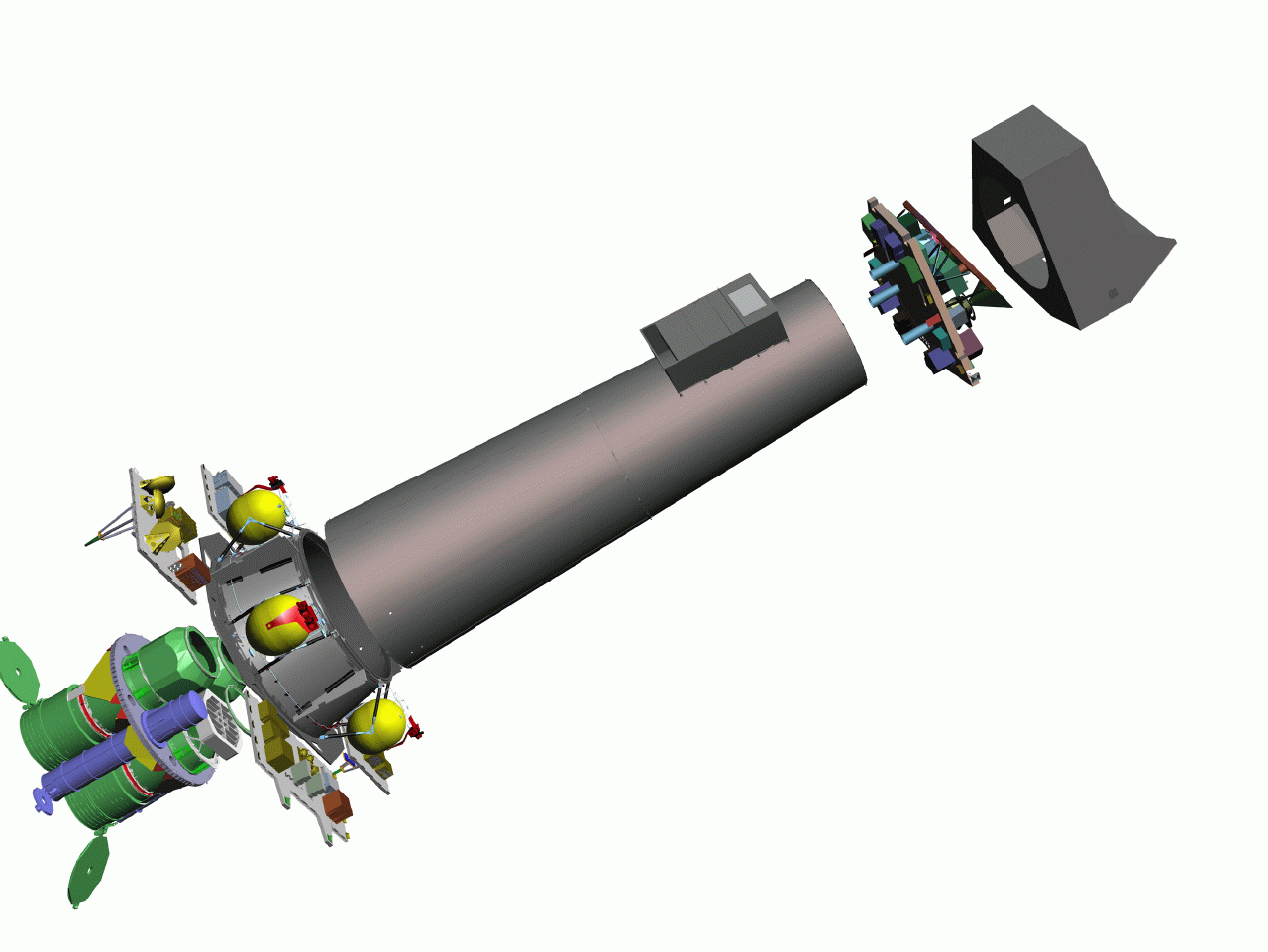THE XMM-NEWTON SATELLITE
-
The basic XMM-Newton satellite design consists of three main
modules
connected by the telescope tube. The first module contains the three
X-ray mirror assemblies and the Optical/UV Monitor (OM). The second
module contains the focal plane instrumentation. The third module is
the service module which is located around the outside of the
telescope tube at the mirror-module end of the satellite. The mass of
the XMM-Newton spacecraft is about 3.9 tonnes. The service module carries
all the equipment for the power, data-handling, attitude,
orbit-control, and telecommunication subsystems. The solar arrays and
telecommunications antennas are folded around the edge of the service
module and are deployed in orbit. The spacecraft subsystems are in
general generic or identical to those of previous or present missions
and have not required any major technological development.

(From the VILSPA XMM-Newton Science Operations Center, courtesy of Dornier Satellitensysteme GmbH.)
The satellite is three-axis stabilized, and has only a modest requirement for absolute pointing accuracy (±1 arc minutes). It was launched by an Ariane 5 and placed in a highly elliptical orbit (47.8 hour synchronous period, 7000 km perigee, 114000 km apogee, see figure above) for a combination of scientific and operational reasons. The perigee is constrained by the requirement that the spacecraft shall not pass through the Earth's proton belt. (Such radiation will cause significant degradation to the CCD cameras, mainly by decreasing the CCD charge-transfer efficiency.) The length of the orbit allows for long, continuous exposures unaffected by Earth blockage. The orbit inclination of 47.8° and azimuth of 18° allows for nearly continuous ground-station coverage from Europe.

(From the VILSPA XMM-Newton Science Operations Center, courtesy of Dornier Satellitensysteme GmbH.)
The figure above shows a schematic view of the XMM-Newton observatory. The X-ray mirrors are shown in green at the lower left end of the spacecraft. The Optical Monitor is shown in blue next to the X-ray mirrors. The two electronics platforms are shown at the right end of the mirrors with the propellant tanks in yellow and the thrusters in red. Next comes the long telescope tube with the platform holding the X-ray cameras at the far right end of the image.
Two of the X-ray mirrors are equipped with reflection grating assemblies, which disperses half of the X-ray beam slightly off axis. This high resolution spectrum is recorded at the focal plane by the Reflection Grating Spectrometer (RGS) detector. The rest of the X-ray beam is focused onto a European Photon Imaging Camera (EPIC). The remaining mirror shell is focused directly onto another EPIC camera head.
| XMM-Newton Focal Plane Instrumentation | ||
|---|---|---|
| Instrument | Objective | PI |
| Prime Focus Camera (EPIC) | Broadband spectrophotometry using CCD arrays on all three telescopes | M. Turner, Leicester (GB) |
| Secondary Focus Spectrometer (RGS) | Medium-resolution spectroscopy using reflection gratings on two telescopes | A.C. Brinkman, SRON, Utrecht (NL) |
| Optical Monitor (OM) | Simultaneous optical coverage of the X-ray telescope field using a 30 cm Cassegrain telescope | K.O. Mason, Mullard Space Science Lab. (UK) |
The three XMM-Newton instruments are highly complimentary combining high spectral and angular resolution in the X-ray range with simultaneous optical/UV monitoring.
If you have any questions concerning XMM-Newton send e-mail to xmmhelp@lists.nasa.gov



